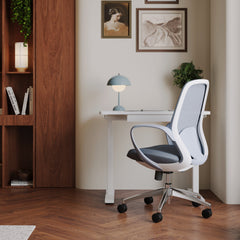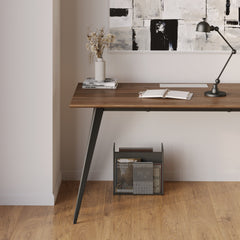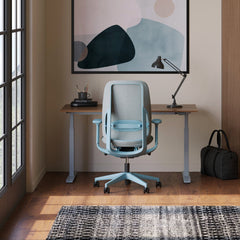Get 10% off your first order
Find the office furniture that’s designed to match your style, comfort, and needs perfectly. Subscribe
Workstations That Evolve with Your Schedule

Visit quiz page to see how we makes it easy to create an inspiring workplace

The choice between buying an office chair locally or online shapes far more than convenience. It influences ergonomic fit, daily comfort, environmental impact, and how confidently you will work for years to come. A thoughtful decision considers how you test support, compare adjustments, validate materials, and coordinate the chair with the rest of the workstation. The right channel for one person may be the wrong channel for another, which is why this guide evaluates both options through the lens of fit, function, and long-term satisfaction.
An office chair is a wearable tool. Small differences in seat depth, lumbar curve, and armrest geometry change joint angles and muscle load across thousands of micro-movements in a week. Channel choice affects whether you can verify those details before purchase, how you interpret specifications, and how easily you can match the chair to your desk height, monitor position, and daily tasks.
Sustained comfort supports focus, circulation, and recovery. Evidence-led practices, such as the guidance summarized by evidence based seating ergonomics from NIOSH, emphasize adjustability and neutral joint positions that reduce strain. These principles apply regardless of where you buy, but the buying path influences how well you can confirm them for your body.

Physical trials expose subtle realities that a product page cannot fully convey. You can feel whether the lumbar pad meets your spine at the right height, whether the seat pan distributes pressure beneath the thighs, and whether the tilt mechanism returns smoothly without abrupt stops. Testing a showroom example such as adjustable lumbar task chair for upright alignment helps you notice micro-fit details like seat front curvature, arm pad texture, and how easily controls adjust while seated.
Local retailers often provide trained staff who translate posture goals into specific settings. They can demonstrate how to dial in recline tension for your body weight or how to set armrest height to keep shoulders quiet during typing. In some locations, same-day pickup, on-site assembly, and face-to-face support create peace of mind for buyers who prefer human guidance.
Brick-and-mortar floors are finite. Selection is limited to what fits the showroom and what a retailer has chosen to stock. You might not see every fabric or mechanism combination. Some stores prioritize faster moving models, which can constrict options for niche needs like extra-long seat depth or compact footprints for small offices.
You want to validate lumbar height, seat contour, and arm geometry with your own body.
You prefer guided setup from a person standing next to you.
You are outfitting multiple workstations and want consistent fit across users through in-person testing.
Online stores provide deep variety and filterable specifications. You can scan different back heights, arm types, and lumbar systems without traveling across town. A comprehensive catalog such as the contemporary ergonomic chair selection allows side-by-side evaluation of styles, materials, and adjustment ranges. This scale is useful if you have precise constraints such as narrow arm-to-arm width for a compact desk.
Modern product pages combine high resolution imagery, full spec tables, and customer reviews. When a listing describes ergonomic office chair engineered for all day comfort, you can cross-check back height, recline range, and foam density against your own posture preferences. Reviews often surface practical details, like whether the arm pads feel grippy enough during mousing or how easily the tilt lock engages.
Online ordering improves access to specific configurations that might not exist on a local floor. It also simplifies coordinating a full setup. If you need a chair, a desk, and storage that align in finish and proportion, a tool such as the custom home office bundle builder helps you assemble a coherent package without guesswork.
You want uncommon options, such as recycled materials or specialized mechanisms.
You like to analyze specifications and read multiple user reviews.
You prefer to coordinate matching components in one session.
| Decision Factor | Local Purchase Strength | Online Purchase Strength | Practical Watchouts |
|---|---|---|---|
| Tactile fit validation | Immediate feel for support and materials | None without a trial | Ask for return policy details in either channel |
| Selection breadth | Curated but limited | Wide and filterable | Beware choice overload without clear criteria |
| Configuration control | Often limited to stocked variants | High, often build to order | Verify lead times and compatibility across pieces |
| Guidance and education | In-person expertise | Reviews, detailed specs, live chat | Vet advice quality and consistency |
| Coordination with other furniture | Visual matching on site | Digital bundling and finish matching tools | Confirm dimensions against your room plan |
| Service and support | Local assembly and repair networks | Centralized support and clear documentation | Keep purchase records and serial numbers handy |
Regardless of where you buy, confirm these critical elements.
1. Seat height and depth
Thighs should be supported without pressure behind the knees. Depth adjustment or varied sizes help different leg lengths.
2. Lumbar height and firmness
The lower back curve benefits from responsive support. Test whether the lumbar pad or contour meets your natural curve.
3. Backrest recline and tension
Smooth, controllable recline reduces static loading. You should lean without sudden drop or stiff resistance.
4. Armrest height, width, and pivot
Elbows should rest near 90 degrees with shoulders relaxed. Adjustable width and pivot help align to your typing reach.
5. Seat and back materials
Mesh breathes well, fabric provides warmth, and molded foams vary in feel. Choose based on climate, clothing, and preference.
A perfectly tuned chair can be undermined by an incompatible desk height. Choosing complementary components, such as the human centered desk collection for height harmony, helps maintain neutral wrist and shoulder positions. If your desk is fixed height, focus on a chair with a height range that keeps elbows close to desk level without lifting shoulders.
Ergonomics and sustainability can work together. If you value recycled content or low-impact finishes, include those requirements in your channel choice and product filters. A model like the recycled materials modern office chair with coastal profile demonstrates how recycled components and refined forms can coexist with supportive geometry.
Sit for several minutes in a neutral typing posture, then in a relaxed recline. Note pressure points.
Change one control at a time. Raise seat height, then lower. Adjust lumbar depth, then reset. Observe which combination feels natural.
Simulate your workflow. Type, reach for an imaginary mouse, and turn as if taking notes. Evaluate arm pad comfort and base stability.
Capture settings on your phone. Record seat height relative to your leg, armrest position, and backrest angle. These notes help if you later order online.
Use dimension diagrams to map elbow, knee, and hip angles to your body.
Read reviews that mention body type and height. Align those comments with your own profile.
Filter by adjustments that solve your specific needs.
If available, order swatches for fabrics and mesh. Texture and color perception vary across screens.

| Workstyle | Daily Pattern | High Priority Adjustments | Useful Materials |
|---|---|---|---|
| Heads-down typist | Long typing blocks with minimal movement | Arm height and pivot, seat depth, lumbar firmness | Fabric or supportive mesh |
| Frequent call taker | Alternates between typing and leaning back | Smooth recline, responsive lumbar, head optional | Breathable mesh |
| Designer or analyst | Mixed mouse work and posture shifts | Fine tilt tension control, arm width, seat pan contour | Durable fabric or hybrid mesh |
| Compact home office | Short sessions across the day | Small footprint, easy glides, quick controls | Slim frame, soft casters for hard floors |
| Shared workstation | Multiple users per day | Wide adjustment ranges, clear markings | Materials that clean easily |
1. Define non-negotiables such as adjustable lumbar or compact size.
2. Choose your channel path based on your preference for tactile testing or variety.
3. Validate ergonomic fundamentals with posture-friendly configuration.
4. Coordinate with your desk and monitor to maintain neutral body alignment.
5. Confirm support and returns before committing to either channel.
A beautiful silhouette cannot compensate for poor ergonomic design. Always prioritize fit and functionality over visual style.
Improper armrest height or width leads to shoulder tension. Choose chairs with adjustable arm configurations that align to your workflow.
High-quality recline mechanisms promote natural motion. A stiff or abrupt tilt can reduce circulation and increase strain.
A supportive chair still needs clearance to move freely. Measure your workspace before finalizing dimensions.
Bodies differ, and each buyer has unique needs. Local stores provide tactile personalization, while online stores deliver broader accessibility. Both contribute to inclusive comfort when approached intentionally.
Pairing accessories like monitor arms and footrests extends ergonomic value. When buying online, bundling these tools creates a complete system; when buying locally, testing them together ensures cohesive alignment.
Search trends reveal that many buyers look for office chairs by proximity—terms like “office chair store near me” or “best ergonomic chairs online” highlight the blend of local discovery and national convenience. Retailers who provide both an online catalog and a physical presence meet this dual intent effectively.
Buying from a local outlet reduces shipping distance and environmental impact, while online retailers with regional warehouses can still deliver efficiently. The best approach considers not just where you buy, but how the distribution model aligns with your values for sustainability and community support.
Voice assistants increasingly guide shoppers with natural questions such as “Where can I test an ergonomic office chair?” or “What’s the best adjustable desk chair for home offices?” Structuring online listings and store pages with conversational, geographically relevant content ensures discoverability in both voice and local search results.
Whether online or local, transparent policies on returns, materials, and warranties improve consumer confidence. Clear descriptions, accessibility features, and easy navigation also support inclusivity, ensuring every user can make an informed decision.
Retail is evolving toward a model where customers test in person, customize online, and receive seamless after-sales support. This fusion of channels minimizes the tradeoff between tactile assurance and selection depth.
Informed buyers demand clarity about how chairs support posture, circulation, and long-term health. Brands that communicate ergonomics clearly will thrive, helping buyers make responsible, comfort-driven choices.
By aligning ergonomic fundamentals with a buying approach that fits your preferences, you turn the process of purchasing an office chair into a confident, knowledge-based decision. Local stores offer tangible validation; online platforms provide boundless variety. Together, they create a balanced path toward healthier, more productive, and more personalized workspaces.

Workstations That Evolve with Your Schedule

Spaces That Shift With You: Building a Workspace That Adapts to Every Task

Room to Think: Designing an Efficient Workspace Without Overcrowding
Get 10% off your first order
Find the office furniture that’s designed to match your style, comfort, and needs perfectly. Subscribe
Leave a comment